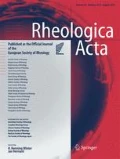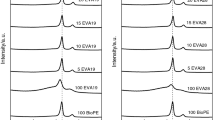Abstract
We investigated the rheological behavior of linear low-density polyethylene (LLDPE)/polylactic acid (PLA) blends in the presence of modified and non-modified silica nanoparticles in extensional flow. Characterization methods were used as Fourier transform infrared spectroscopy, scanning electron microscopy, and rheometric measurements under shear and uniaxial extensional flows. The rheology behavior of LLDPE significantly was changed by the addition of PLA and silica nanoparticles. Extensional results showed that the elongational viscosity of the blends intensified by the incorporation of silica nanoparticles. Strain hardening was observed for LLDPE containing 2 wt.% of the unmodified silica nanoparticles, which disappeared by enhancement of the unmodified silica from 2 to 8 wt.%. Furthermore, elongation thinning was observed for the filled blends at high loading, which was more sensitive to the strain rate by increasing of PLA. Surface modification of silica was demonstrated in different elongational behavior. Indeed, a fracture took place by loading the modified silica nanoparticles in LLDPE; however, the intensity of this behavior dramatically increased for filled blends with a high loading of modified silica.

Graphical abstract






Similar content being viewed by others
References
Alimardani M, Razzaghi-Kashani M, Karimi R, Mahtabani A (2016) Contribution of mechanical engagement and energetic interaction in the reinforcement of SBR-silane–treated silica composites. Rubber Chem Technol 89:292–305
As'habi L, Jafari SH, Khonakdar HA, Häussler L, Wagenknecht U, Heinrich G (2013) Non-isothermal crystallization behavior of PLA/LLDPE/nanoclay hybrid: synergistic role of LLDPE and clay. Thermochim Acta 565:102–113
Chambon F, Winter HH (1987) Linear viscoelasticity at the gel point of a crosslinking PDMS with imbalanced stoichiometry. J Rheol 31:683–697
Cui G, Boudara VA, Huang Q, Baeza GP, Wilson AJ, Hassager O, Mattsson J (2018) Linear shear and nonlinear extensional rheology of unentangled supramolecular side-chain polymers. J Rheol 62:1155–1174
de Luna MS, Filippone G (2016) Effects of nanoparticles on the morphology of immiscible polymer blends–challenges and opportunities. Eur Polym J 79:198–218
Delgadillo-Velázquez O, Hatzikiriakos S (2008) Capillary extrusion studies of LLDPE/LDPE blends effects of manufacturing technology of LLDPE and long-chain branching. Int Polym Process 23:385–394
Dorigato A, Pegoretti A (2012) Fracture behavior of linear low-density polyethylene–fumed silica nanocomposites. Eng Fract Mech 79:213–224
Elias L, Fenouillot F, Majesté JC, Martin G, Cassagnau P (2008) Migration of nano-silica particles in polymer blends. J Polym Sci B Polym Phys 46:1976–1983
Farhan M, Ab Aziz B, Mohamed R (2013) Biodegradability of starch-based films blend with LLDPE and PVA. Adv Mater Res 795:115–118
Foroozan A, Behboodi T, Jahani Y (2019) The influence of branching efficiency on the rheology and morphology of melt state long-chain branched polypropylene/polybutene-1 blends. Polyolefins J 6:1–11
Francis V, Subin SR, Bhat SG, Thachil ET (2012) Characterization of linear low-density polyethylene/poly (vinyl alcohol) blends and their biodegradability by Vibrio sp. isolated from the marine benthic environment. J Appl Polym Sci 124:257–265
Gonzalez-Nunez R, Arellano M, Moscoso F, Gonzalez-Romero V, Favis B (2001) Determination of a limiting dispersed phase concentration for coalescence in PA6/HDPE blends under extensional flow. Polymer 42:5485–5489
Haghtalab A, Marzban R (2011) Viscoelastic properties of nano-silica-filled polypropylene in the molten state: effect of particle size. Adv Polym Technol 30:203–218
Han CD (2012) Rheology and processing of polymeric materials: volume 1: polymer rheology. Oxford University Press on Demand
Hassan MM, Takahashi T, Koyama K (2019) Thermal stability, mechanical properties, impact strength, and uniaxial extensional rheology of reactive blends of PS and SBS polymers. Polym Bull:1–21
Hassanabadi HM, Rodrigue D (2012) Relationships between the linear and nonlinear shear response of polymer nanocomposites. Rheol Acta 51:991–1005
Hedegaard AT, Gu L, Macosko CW (2015) Effect of extensional viscosity on continuity of immiscible polymer blends. J Rheol 59:1397–1417
Hong JS, Ahn KH, Lee SJ (2005) Strain hardening behavior of polymer blends with fibril morphology. Rheol Acta 45:202–208
Hoseini M, Haghtalab A, Family MHN (2017) Rheology and morphology study of immiscible linear low-density polyethylene/poly (lactic acid) blends filled with nano-silica particles. J Appl Polym Sci:134
Hotta S, Paul D (2004) Nanocomposites formed from linear low-density polyethylene and organoclays. Polymer 45:7639–7654
Hrnjak-Murgić Z, Jelčić Ž, Kovačević V, Mlinac-Mišak M, Jelenčić J (2002) Molecular and morphological characterization of immiscible SAN/EPDM blends filled by nanofiller. Macromol Mater Eng 287:684–692
Huang S, Bai L, Trifkovic M, Cheng X, Macosko CW (2016) Controlling the morphology of immiscible co-continuous polymer blends via silica nanoparticles jammed at the interface. Macromolecules 49:3911–3918
Khandavalli S, Rothstein JP (2014) Extensional rheology of shear-thickening fumed silica nanoparticles dispersed in an aqueous polyethylene oxide solution. J Rheol 58:411–431
Kong M, Huang Y, Lv Y, Yang Q, Li G, Larson RG (2018) Elongation thinning and morphology deformation of nanoparticle-filled polypropylene/polystyrene blends in elongational flow. J Rheol 62:11–23
Leopoldes J, Barres C, Leblanc J, Georget P (2004) Influence of filler–rubber interactions on the viscoelastic properties of carbon-black-filled rubber compounds. J Appl Polym Sci 91:577–588
Li Q, Zeng Q, Huang Y, Lv Y, Li Q, Yang Q (2013) Dispersion and rheology of polypropylene/organoclay nanocomposites: effect of cation exchange capacity and the number of alkyl tails. J Mater Sci 48:948–959
Ock HG, Ahn KH, Lee SJ, Hyun K (2016) Characterization of compatibilizing effect of organoclay in poly (lactic acid) and natural rubber blends by FT-rheology. Macromolecules 49:2832–2842
Osman MA, Atallah A (2006) Effect of the particle size on the viscoelastic properties of filled polyethylene. Polymer 47:2357–2368
Pai F-C, Chu H-H, Lai S-M (2011) Reactive compatibilization of poly (lactic acid)/polyethylene octene copolymer blends with ethylene-glycidyl methacrylate copolymer. J Polym Eng 31:463–471
Raos G, Moreno M, Elli S (2006) Computational experiments on filled rubber viscoelasticity: what is the role of particle− particle interactions? Macromolecules 39:6744–6751
Rusmirović J, Trifković K, Bugarski B, Pavlović V, Džunuzović J, Tomić M, Marinković A (2016) High-performance unsaturated polyester-based nanocomposites: effect of vinyl modified nano-silica on mechanical properties. Express Polym Lett:10
Saiz-Arroyo C, Escudero J, Rodriguez-Perez M, De Saja J (2011) Improving the structure and physical properties of LDPE foams using silica nanoparticles as an additive. Cell Polym 30:63–78
Sentmanat ML (2004) Miniature universal testing platform: from extensional melt rheology to solid-state deformation behavior. Rheol Acta 43:657–669
Sentmanat M, Wang BN, McKinley GH (2005) Measuring the transient extensional rheology of polyethylene melts using the SER universal testing platform. J Rheol 49:585–606
Shimpi NG, Borane M, Mishra S (2016) TiO 2/polystyrene core-shell nanoparticles as fillers for LLDPE/PLA blend: development, and morphological, thermal and mechanical properties. Polym Bull 73:3049–3063
Song Y, Zheng Q (2015) Linear rheology of nanofiller polymers. J Rheol 59:155–191
Stępień M, Figiel Ł (2015) Morphology evolution and macroscopic behavior of PLA-organoclay nanocomposites during extensional rheology: experimental study. Polym Test 42:79–88
Tanoue S, Utracki LA, Garcia-Rejon A, Tatibouët J, Cole KC, Kamal MR (2004) Melt compounding of different grades of polystyrene with organoclay. Part 1: compounding and characterization. Polym Eng Sci 44:1046–1060
Wu F, Zhang B, Yang W, Liu Z, Yang M (2014) Inorganic silica functionalized with PLLA chains via grafting methods to enhance the melt strength of PLLA/silica nanocomposites. Polymer 55:5760–5772
Xie H-Q, Xu J, Zhou S (1991) Polymer blends with two kinds of elastomeric ionomers. Polymer 32:95–102
Yaoita T, Isaki T, Masubuchi Y, Watanabe H, Ianniruberto G, Marrucci G (2011) Primitive chain network simulation of elongational flows of entangled linear chains: role of finite chain extensibility. Macromolecules 44:9675–9682
Acknowledgments
The authors would like to thank professor Ole Hassager and Qian Huang from the Technical University of Denmark and Danish Polymer Center (DPC) for hosting Maryam Hoseini, and providing financial support, technical assistance and data.
Funding
The authors would like to thank vice president of Research and Technology of Tarbiat Modares University for financial support of this work.
Author information
Authors and Affiliations
Corresponding author
Additional information
Publisher’s note
Springer Nature remains neutral with regard to jurisdictional claims in published maps and institutional affiliations.
Electronic supplementary material
ESM 1
(PDF 523 kb)
Rights and permissions
About this article
Cite this article
Hoseini, M., Haghtalab, A. & Family, M.H.N. Elongational behavior of silica nanoparticle-filled low-density polyethylene/polylactic acid blends and their morphology. Rheol Acta 59, 621–630 (2020). https://doi.org/10.1007/s00397-020-01225-5
Received:
Revised:
Accepted:
Published:
Issue Date:
DOI: https://doi.org/10.1007/s00397-020-01225-5




